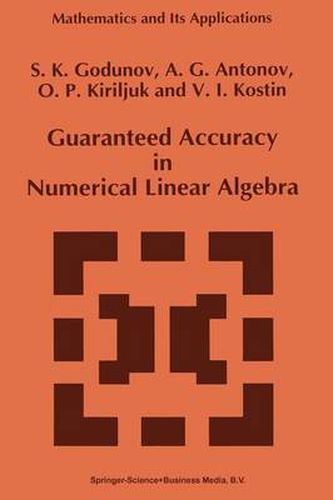Readings Newsletter
Become a Readings Member to make your shopping experience even easier.
Sign in or sign up for free!
You’re not far away from qualifying for FREE standard shipping within Australia
You’ve qualified for FREE standard shipping within Australia
The cart is loading…






This title is printed to order. This book may have been self-published. If so, we cannot guarantee the quality of the content. In the main most books will have gone through the editing process however some may not. We therefore suggest that you be aware of this before ordering this book. If in doubt check either the author or publisher’s details as we are unable to accept any returns unless they are faulty. Please contact us if you have any questions.
There exists a vast literature on numerical methods of linear algebra. In our bibliography list, which is by far not complete, we included some monographs on the subject [46], [15], [32], [39], [11], [21]. The present book is devoted to the theory of algorithms for a single problem of linear algebra, namely, for the problem of solving systems of linear equations with non-full-rank matrix of coefficients. The solution of this problem splits into many steps, the detailed discussion of which are interest ing problems on their own (bidiagonalization of matrices, computation of singular values and eigenvalues, procedures of deflation of singular values, etc. ). Moreover, the theory of algorithms for solutions of the symmetric eigenvalues problem is closely related to the theory of solv ing linear systems (Householder’s algorithms of bidiagonalization and tridiagonalization, eigenvalues and singular values, etc. ). It should be stressed that in this book we discuss algorithms which to computer programs having the virtue that the accuracy of com lead putations is guaranteed. As far as the final program product is con cerned, this means that the user always finds an unambiguous solution of his problem. This solution might be of two kinds: 1. Solution of the problem with an estimate of errors, where abso lutely all errors of input data and machine round-offs are taken into account. 2.
$9.00 standard shipping within Australia
FREE standard shipping within Australia for orders over $100.00
Express & International shipping calculated at checkout
Stock availability can be subject to change without notice. We recommend calling the shop or contacting our online team to check availability of low stock items. Please see our Shopping Online page for more details.
This title is printed to order. This book may have been self-published. If so, we cannot guarantee the quality of the content. In the main most books will have gone through the editing process however some may not. We therefore suggest that you be aware of this before ordering this book. If in doubt check either the author or publisher’s details as we are unable to accept any returns unless they are faulty. Please contact us if you have any questions.
There exists a vast literature on numerical methods of linear algebra. In our bibliography list, which is by far not complete, we included some monographs on the subject [46], [15], [32], [39], [11], [21]. The present book is devoted to the theory of algorithms for a single problem of linear algebra, namely, for the problem of solving systems of linear equations with non-full-rank matrix of coefficients. The solution of this problem splits into many steps, the detailed discussion of which are interest ing problems on their own (bidiagonalization of matrices, computation of singular values and eigenvalues, procedures of deflation of singular values, etc. ). Moreover, the theory of algorithms for solutions of the symmetric eigenvalues problem is closely related to the theory of solv ing linear systems (Householder’s algorithms of bidiagonalization and tridiagonalization, eigenvalues and singular values, etc. ). It should be stressed that in this book we discuss algorithms which to computer programs having the virtue that the accuracy of com lead putations is guaranteed. As far as the final program product is con cerned, this means that the user always finds an unambiguous solution of his problem. This solution might be of two kinds: 1. Solution of the problem with an estimate of errors, where abso lutely all errors of input data and machine round-offs are taken into account. 2.